Flower bed ideas: 24 stunning ways to create floral displays in your garden
Discover these show-stopping flower bed ideas – from color schemes and planting picks to tips on where to place them

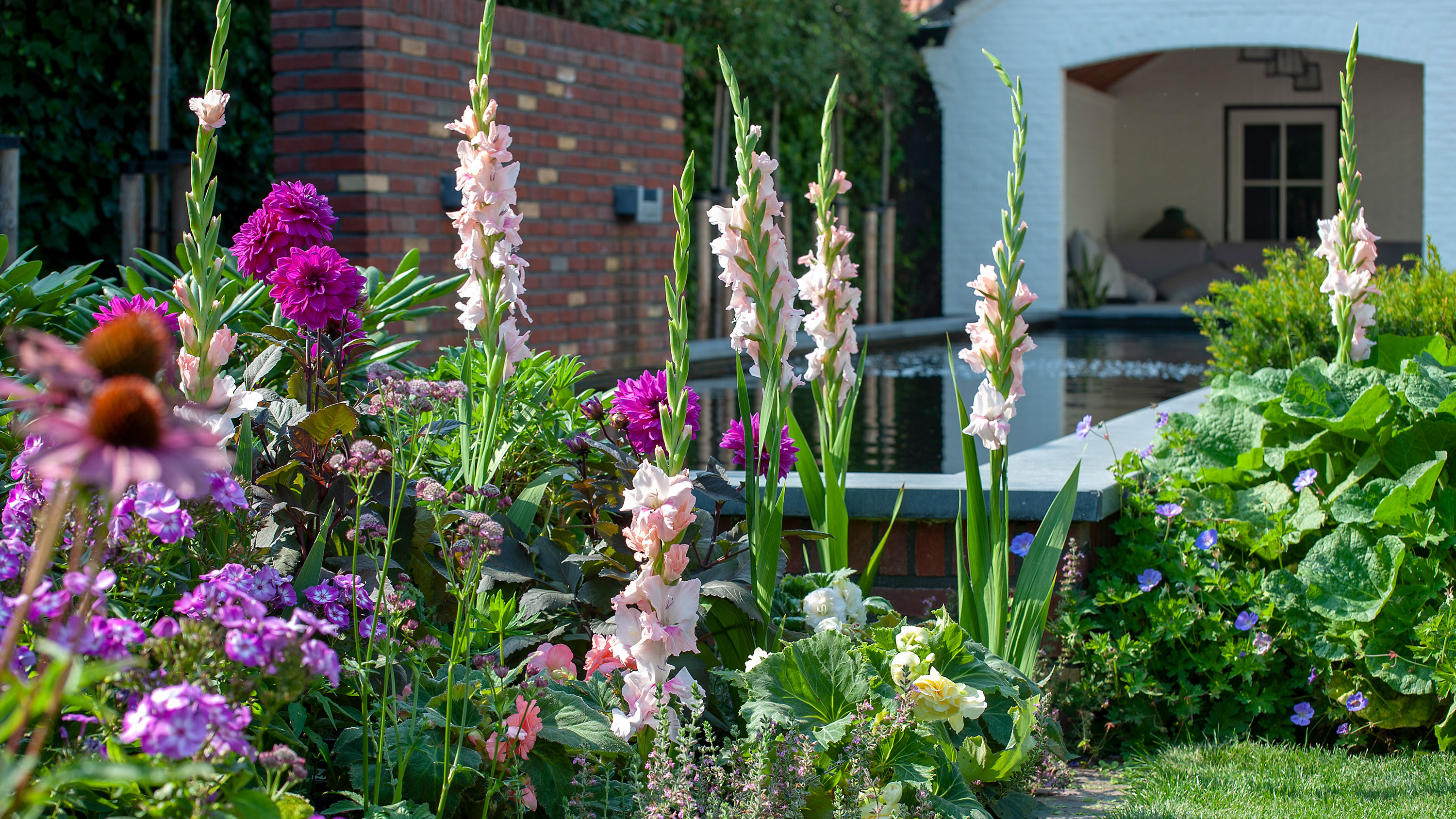
Looking for some new flower bed ideas in time for summer? Maybe your garden could do with a few more blooms – after all, you can seldom have too many in our book. Or, perhaps you've taken over a brand new plot and are looking for creative ways to transform it into the flower-filled haven of your dreams.
Well, you've come to the right place, because we've pulled together some of our very favorite flower bed ideas for you to peruse. From flame-toned displays and contemporary designs to cottage-garden borders, we've got tons of styles to get you thinking about your own plot.
And, you'll find plenty of useful tips for incorporating them into your garden design ideas, including ways to position them to create the most impact.
24 fabulous flower bed ideas to recreate in your space
Whatever your budget or the size of your space, you're bound to find something you love from these inspiring looks.
1. Create a contemporary look with a black backdrop
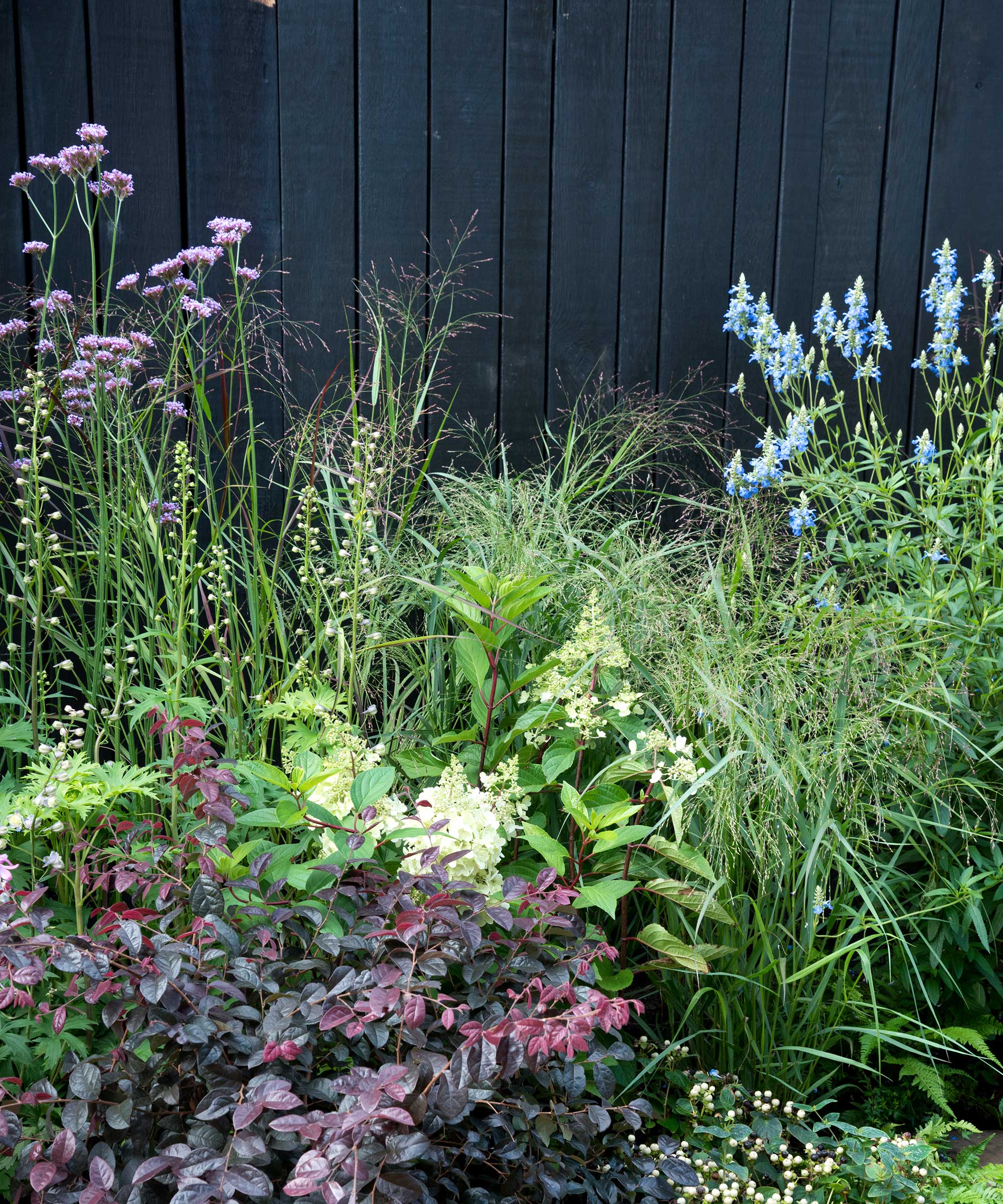
The backdrop to your flower bed can have a huge impact on the overall aesthetic of the space. So, it's well worth working it into your plans for a truly pulled-together look.
One easy way to do this is by focusing on wall or garden fence color ideas and considering how they can be used to enhance your planting. For instance, this charcoal-colored fence allows the tonal-hued plants in front to really pop, and gives the scene a contemporary feel.
We love the mix of textures in the scheme, too, which includes Salvia uliginosa, Verbena bonariensis, grasses, and Hydrangea paniculata.
2. Use a flower bed to line a zone

Whether planted in raised garden beds or straight into the ground, flower beds can make excellent garden dividers. Here, alliums bob elegantly beneath deciduous trees not yet in leaf, and above evergreen shrubs getting ready to flower.
Muscari in its vivid blue hue adds an extra dose of visual interest alongside the lawn.
3. Mix bold flowers with soft grasses
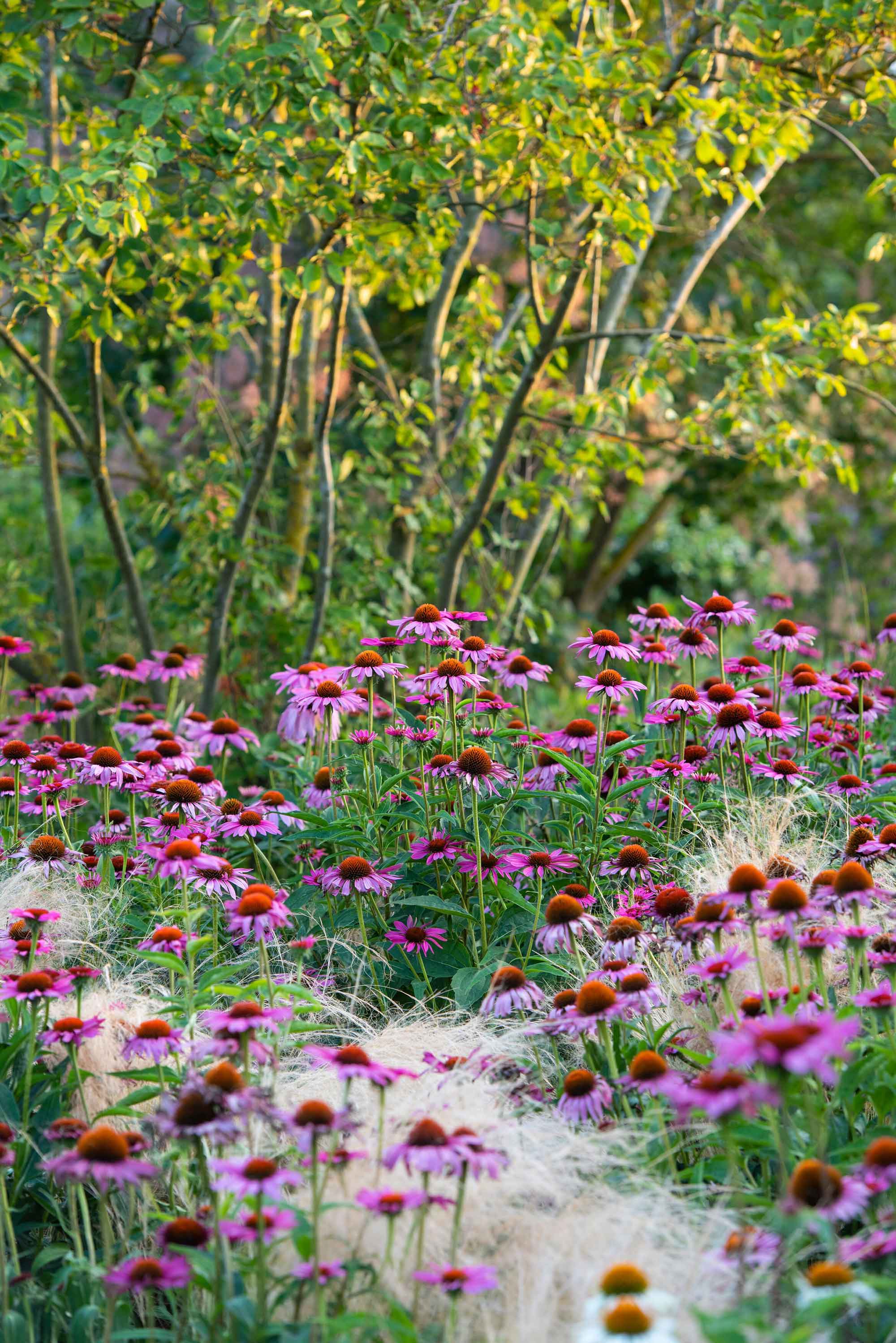
You don't have to cram in lots of different types of flowers for a show-stopping display. This example above demonstrates how two varieties can be just as effective.
The sumptuous pink tone and distinct structure of echinacea make it the perfect match for the feathery and ethereal stipa. Together, they provide an enchanting vista of contrasting textures and color, offset by the backdrop of leaves and elegant branches from a small tree.
Our advice on how to grow ornamental grasses is a great place to start if you want to recreate the look in your own backyard, as is our guide to the best trees for small gardens.
4. Surround a small pond with bright blooms
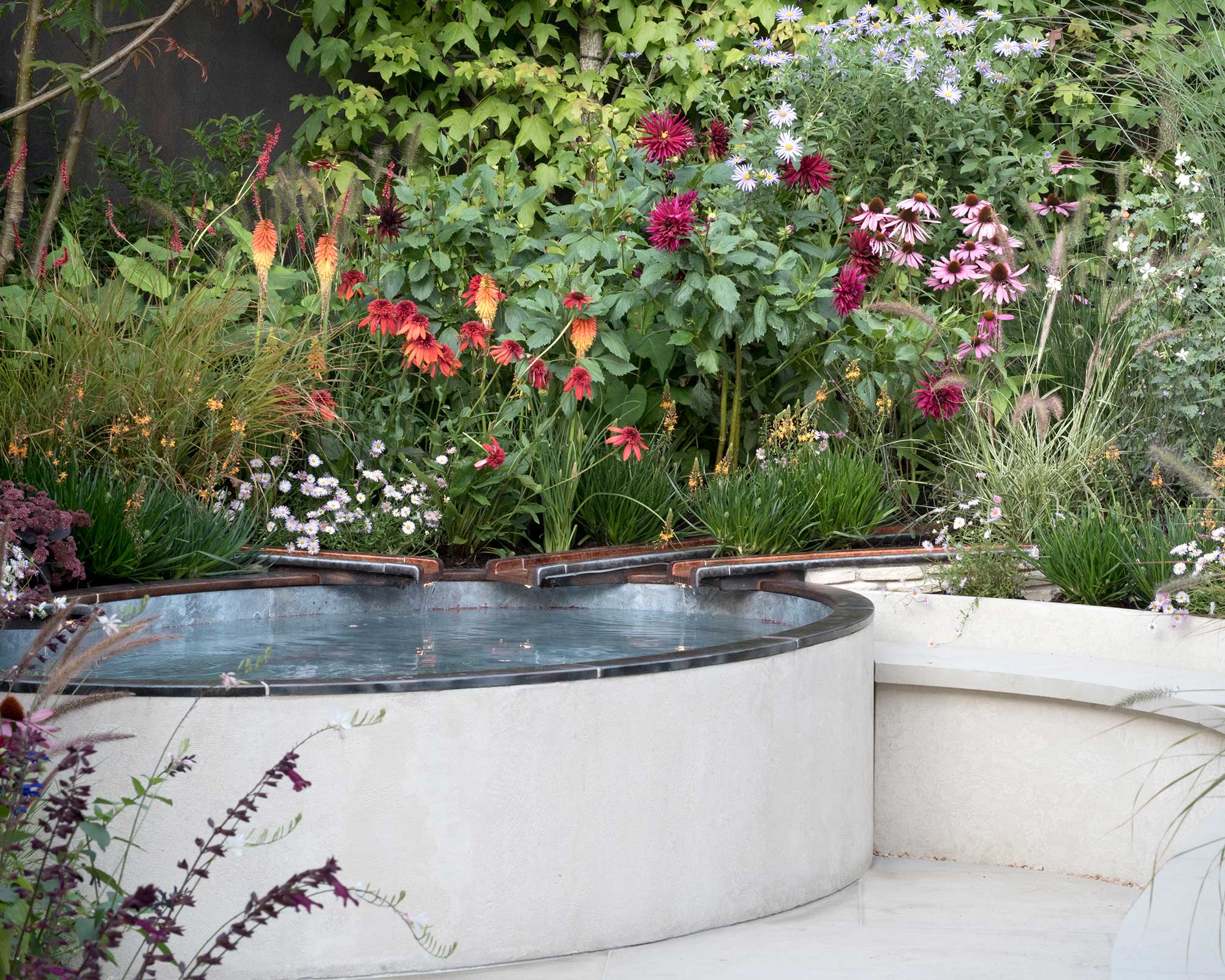
Surrounding a small garden pond with raised flower beds filled with bright blooms is a surefire way to elevate the zone.
Here, a colorful mix of plants has been chosen with a good variation of heights, providing a rich tapestry of texture and form. It does a wonderful job at softening the hardscaping and upping the sensory appeal of the space, and it will welcome lots of pollinators to the zone, too.
Our favorite flower choices in this scheme have to be the show-stopping echinacea – including a fiery orange variety – which complement the deep pink dahlias beautifully. We like the use of erigeron, too, with its delicate white blooms that will scramble over the edges as it grows.
5. Add vibrancy to your balcony flower beds

At first, small balcony gardens may feel a little limiting, particularly when it comes to planting. True, there's no ground for digging and turning into borders or flower beds, but you can still create a gorgeous display with the use of slimline, lightweight planters around the perimeter.
In this show garden, the tall planters are packed with beautiful, bee-friendly choices, including helianthus, salvias, and asters. In such a small space, it's wise to stick to a minimal color palette such as the purple and yellow tones used here – this will keep the zone feeling calm and considered, rather than fussy or chaotic.
It's also a good way to up the sense of privacy, as the planting acts as an all-natural screen.
6. Combine blooms with ornamental veg
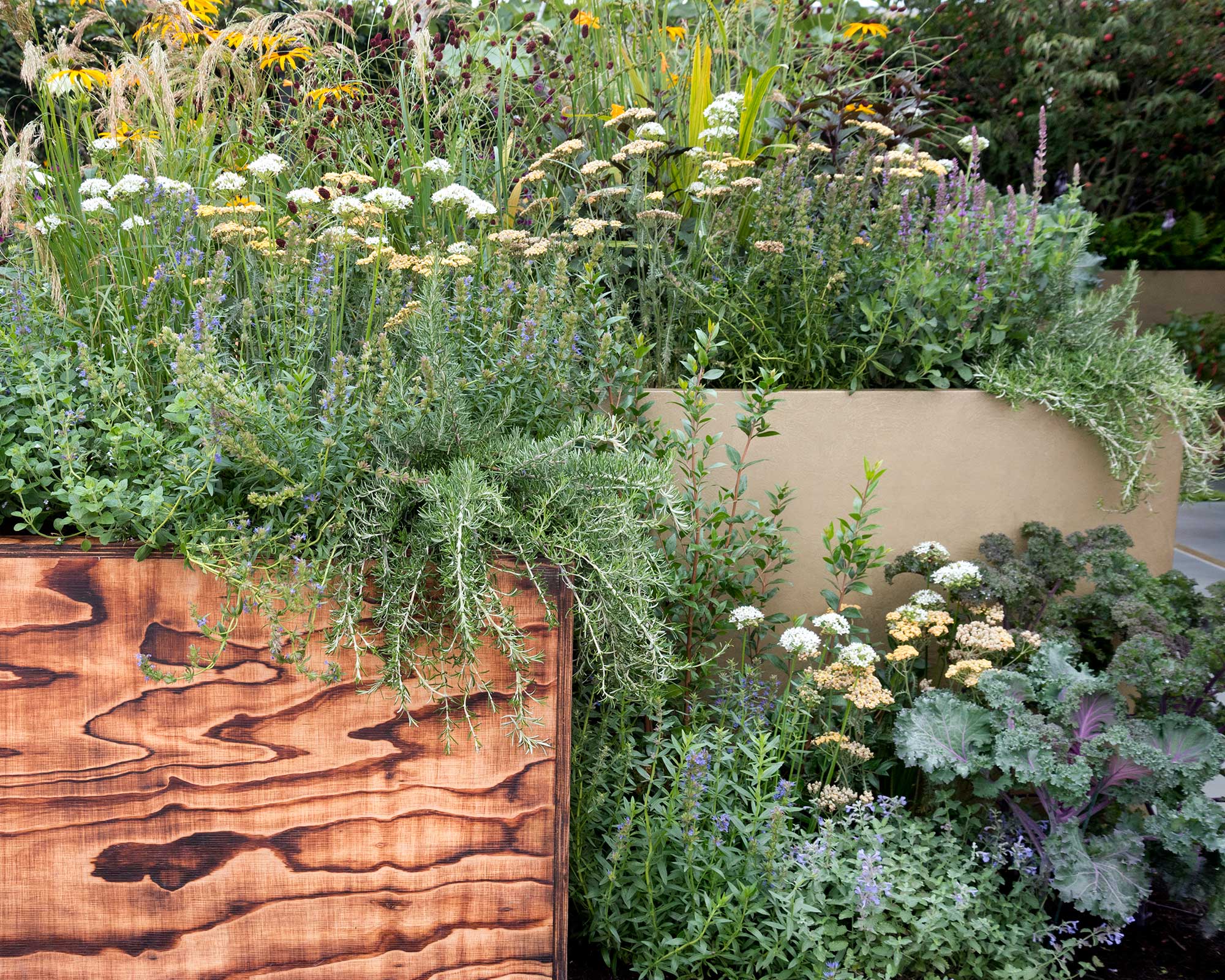
If you love a more informal, colorful look for your yard, then perhaps a potager garden will appeal. This type of planting combines colorful flowers with attractive herbs and veggies, resulting in a joyous mix that is both picturesque and practical.
For example, think ornamental cabbages and rainbow chard planted alongside edible flowers and fragrant rosemary, mint (planted in a sunken pot so it doesn't take over), or perhaps chives with their pink pom-pom blooms.
7. Add sculptures for extra interest
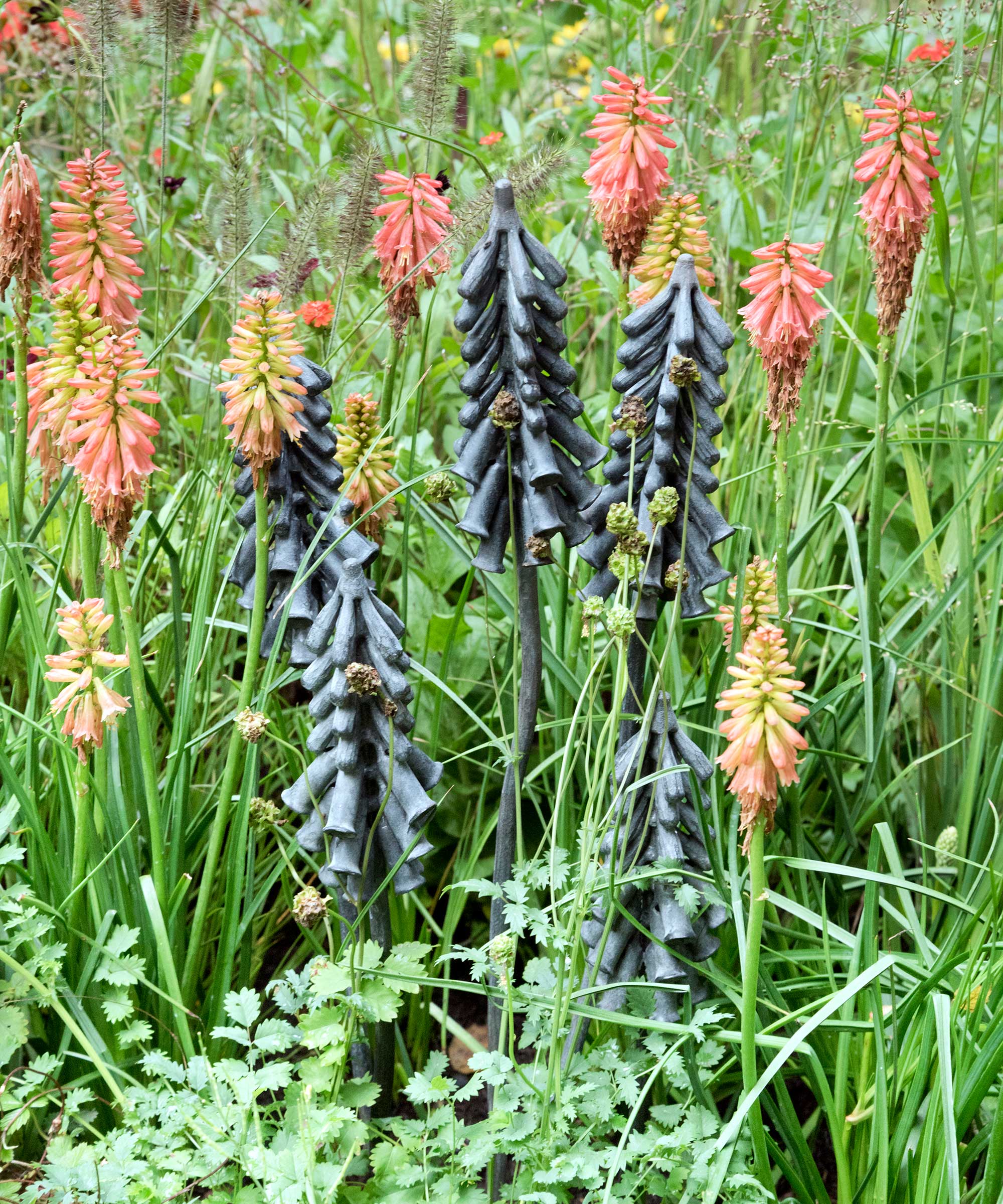
You can add intriguing accents to your flower beds with sculptures, as seen here. Tuck them amongst the planting and they'll provide a welcome surprise for any onlooker who spots them.
There are so many styles to choose from, from contemporary shapes to cute animal figures – but we particularly love metal, floral designs like these. And the best part is, they will continue providing a focal point to the space when the seasons change and the surrounding plants die back.
8. Keep it low-maintenance with drought-tolerant picks

If you're short on time, or simply want to make your garden a little more sustainable in the face of climate change, opting for flower beds filled with drought-tolerant plants is a wise move.
This garden, designed by Tom Stuart-Smith, was a highlight at RHS Hampton Court Garden Festival 2021 and features all kinds of gorgeous blooms, grasses, and Mediterranean shrubs. The tonal palette of silvers and mauves punctuated by splashes of acid green and reds adds to the appeal, and you can bet that visiting butterflies and bees will adore it.
9. Plant up your paving
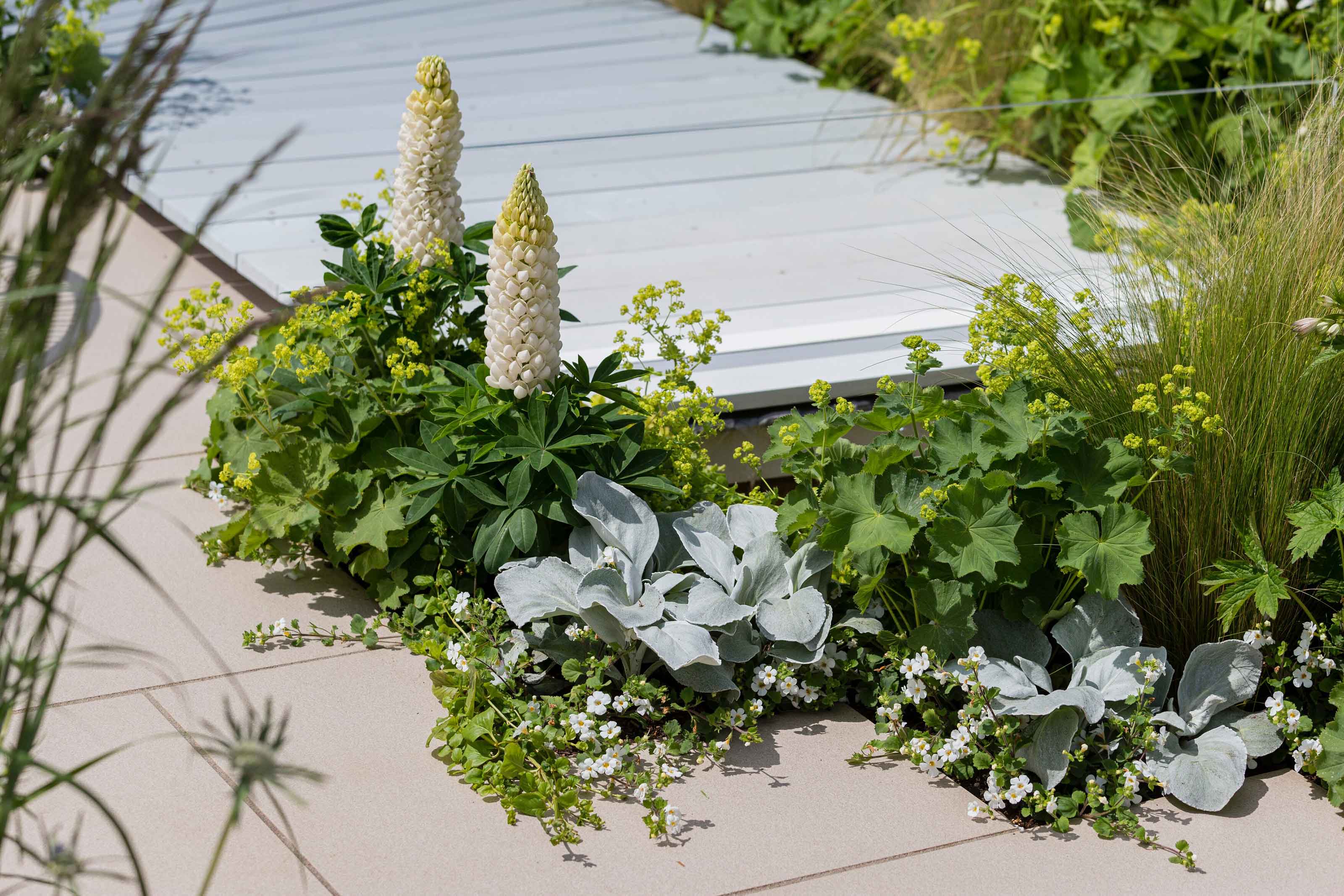
Bringing small pockets of flowers and foliage to your paving or around your decking is a simple way to give them a boost and soften all those hard lines.
For a harmonious look, opt for colors that will match the materials. Here, white flowers and the silvery foliage of Senecio 'Angel Wings' complement the surrounding pale tones, whilst Alchemilla mollis adds a refreshing splash of green. Plus, alchemilla looks beautiful when sparkling raindrops catch upon its leaves.
10. Go for moody tones in your flower bed
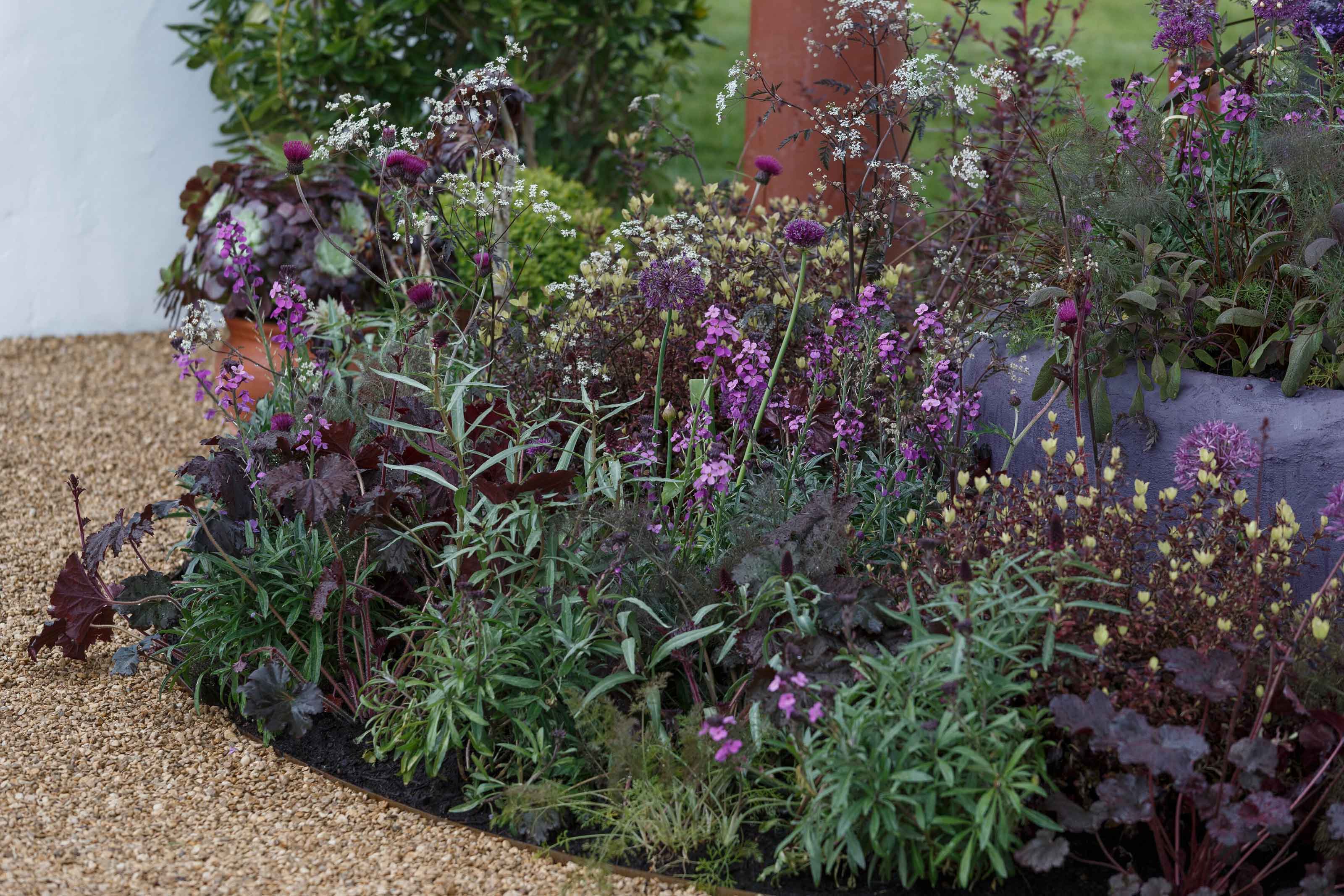
Have you picked a garden color scheme for your plot? Flower bed ideas are a great way to channel your choices and amplify the theme.
Whether you choose serene white tones, show-stopping brights, modern black plants, or sultry shades, opting for a consistent palette will give your space a pulled-together look. But, if it's drama and mood that you're after, you can't go far wrong with deep purple flowers and plum-hued foliage.
There are lots to choose from – think alliums for structure; chocolate lace flower and brook flower for a more meadow-like feel; heuchera for its prettily-scalloped foliage; feathery and aniseed-scented bronzed fennel; or the 'Bowl's Mauve' wallflower for a cottage garden classic.
Up the opulent-yet-mysterious vibe further by picking a dark stone raised bed or lead-effect planters to position your displays in.
11. Bring in supports for climbing plants
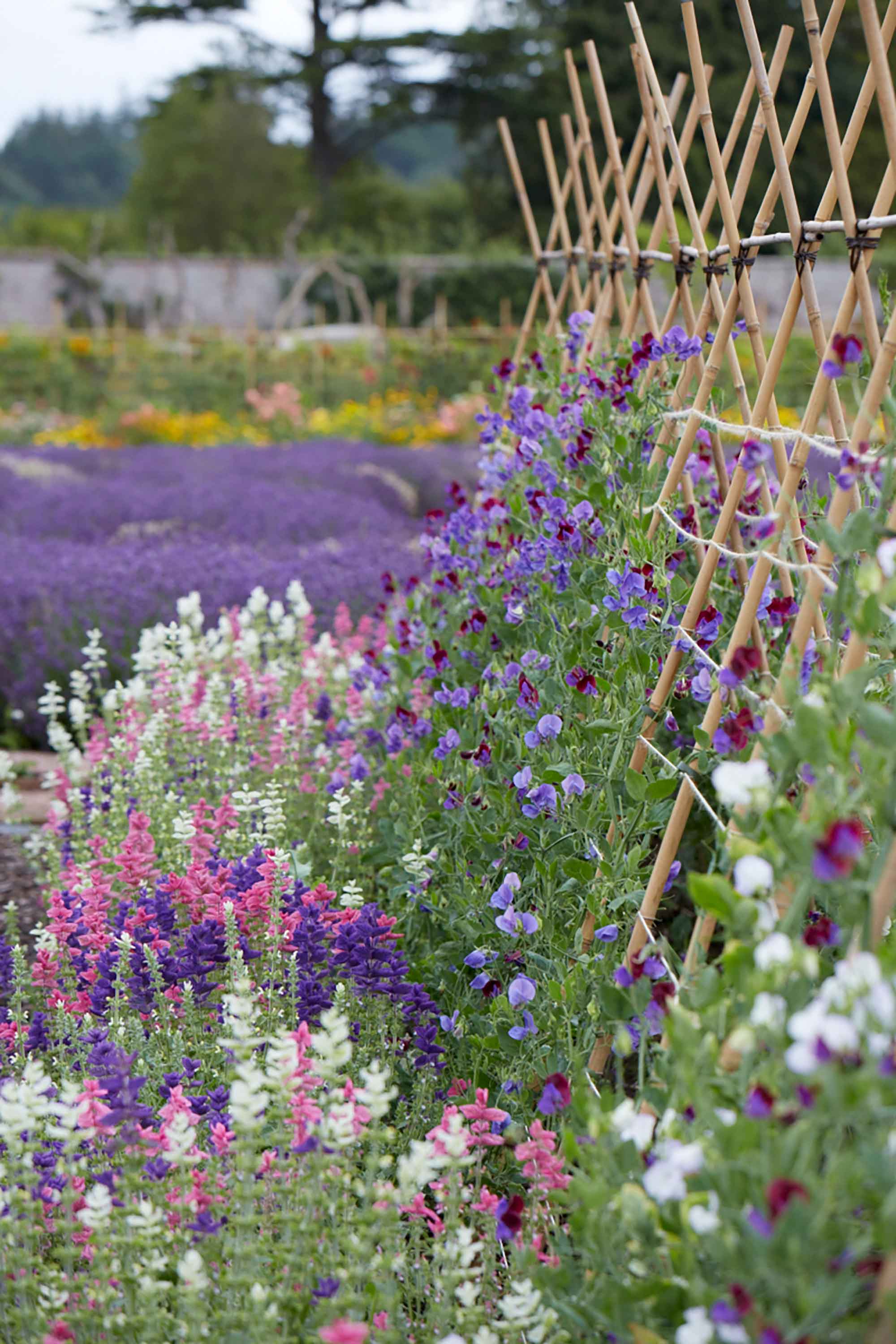
Flower bed ideas are most striking when there's vertical interest involved, but you don't have to rely on the plants alone to reach such heights. Supports will provide all the structure that climbers need to scramble upwards effortlessly, and can make a pretty feature in their own right, too.
There are tons of obelisks, trellises, arbors, and other designs available to buy, or if you fancy a spot of DIY, you can make your own support from bean poles. Whichever you choose, they will instantly elevate a flower bed when combined with the likes of clematis, climbing roses, jasmine, honeysuckle, or, as seen here, mounds of heavenly-scented sweet peas.
Feeling inspired? Our guide on how to grow sweet peas has lots of advice to help you add them to your own plot.
12. Place flower beds alongside a stream for a natural vibe
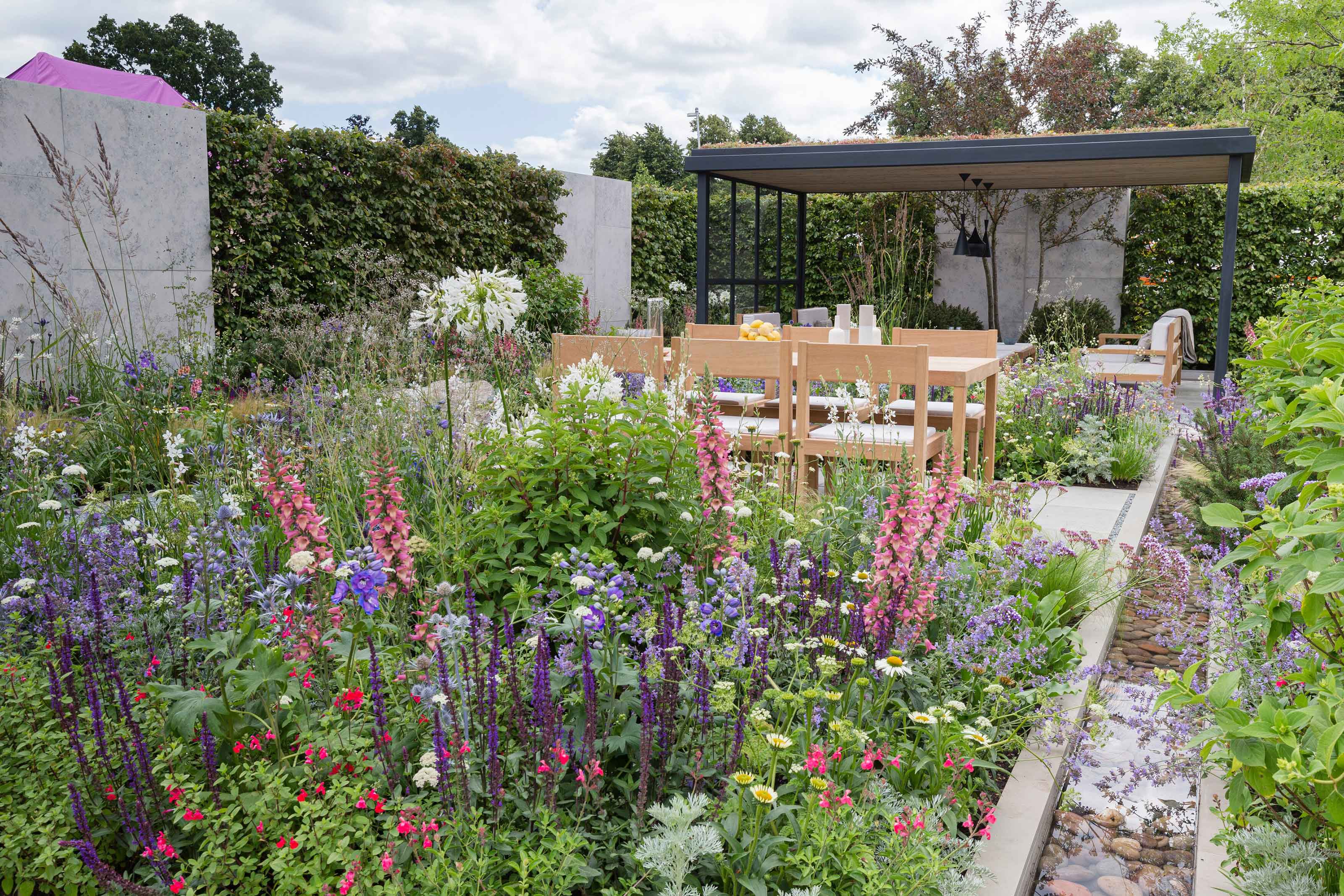
If you've checked out our wildlife garden ideas, you'll know that plenty of nectar-rich blooms are ideal for attracting pollinators to your plot. So to welcome the visiting butterflies and bees, provide a feast of color with large swathes of cottage-garden style planting.
Digitalis, delphiniums, penstemons, salvias, and agapanthus are all beautiful choices and will provide architectural structure as well as vibrant tones. Nepeta 'Walkers Low' makes a good edging plant around the borders with its pretty violet-colored flowers and aromatic scent.
Go for angular-shaped beds surrounded by sleek paving to keep the look feeling considered rather than chaotic. A water feature nearby makes a lovely and naturalistic addition and will only encourage wildlife further.
13. Break up your patio with bulbs
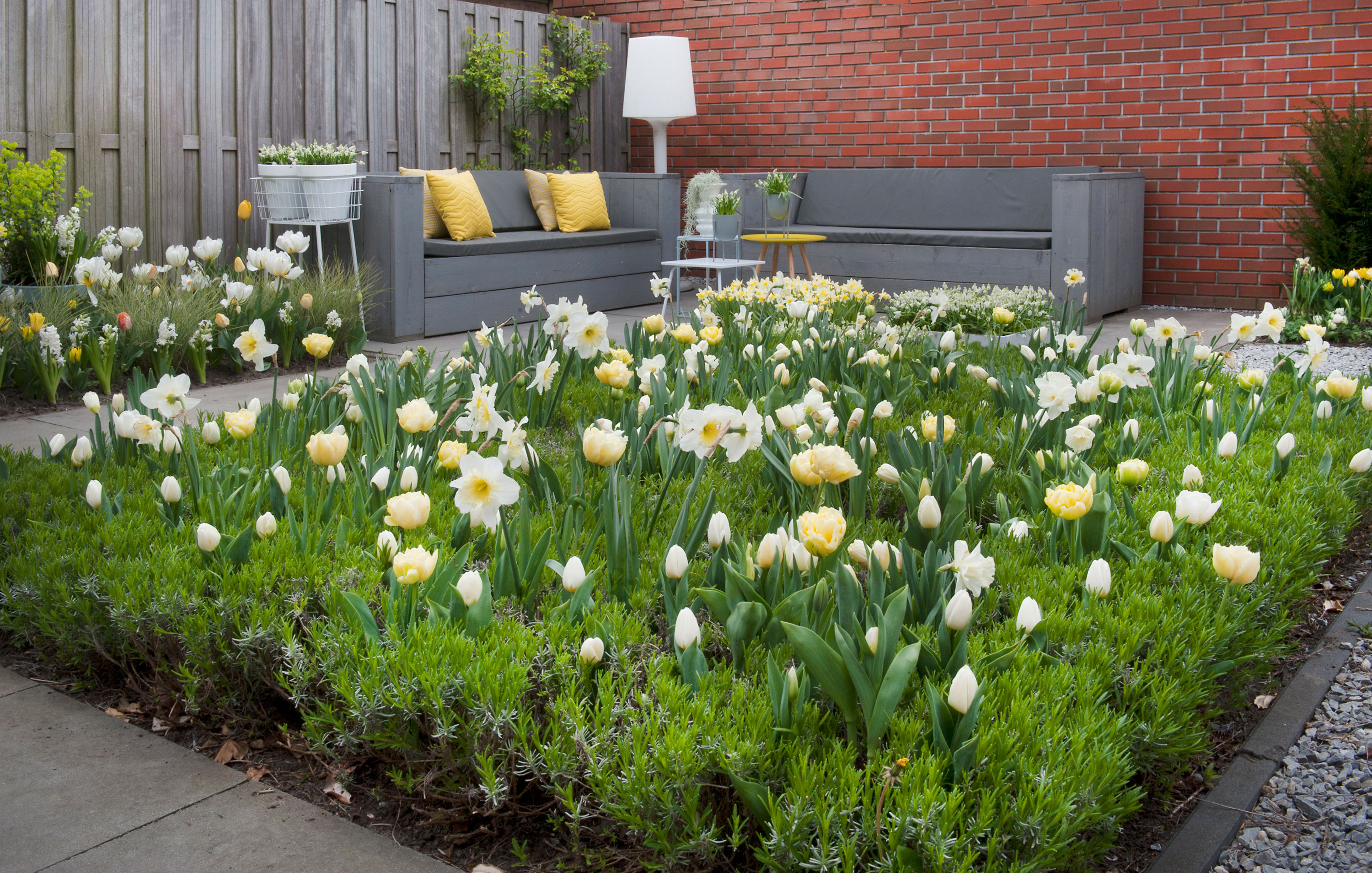
Add a burst of greenery to your patio by introducing a flower bed focal point. This square-shaped patch adds a fresh, lemon-sorbet-like zing to the space, with its daffodils and tulips in pastel yellows and whites.
When they die down, the lavender will come into its glory, sporting spikes of fragranced purple blooms we all know and love. It provides the perfect view for the nearby seating spot and is a fabulous way to elevate an urban plot or courtyard.
14. Go for organic forms

If neat and orderly flower beds aren't your style, this idea might be the one for you.
Firstly, opt for organic shapes to add a wilder edge to a plot or paved space. When it comes to planting, layer up textures in a stripped-back palette for a considered yet natural feel. We adore the use of hydrangeas, ferns, hardy geraniums, and wispy grasses as seen here, in their cool green tones.
Complement the look with a rustic water feature, birdbath, or giant stone urn to add to the old-world feel.
15. Use jewel-like hues around water
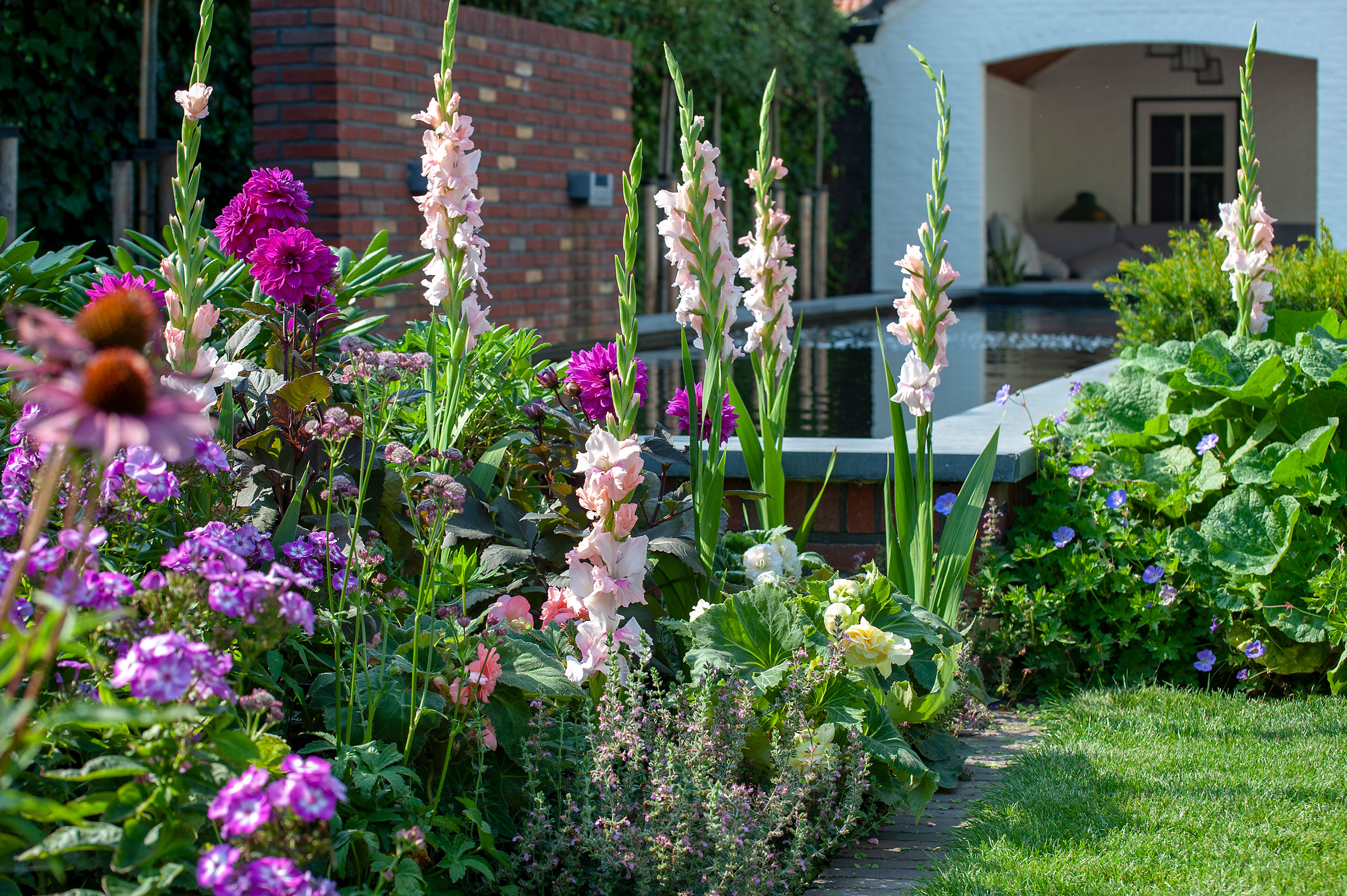
This flower bed offers a sumptuous summer display, combining the likes of echinacea, phlox, nepeta, astrantia, and hardy geraniums. The rich hues of pink and purples are offset wonderfully by the prettily-pastel gladiolus. And, the scene will attract butterflies and bees too, adding an extra dose of life and vibrancy to your plot.
A shimmering water feature adds to the opulent vibe of the display, reflecting the jewel-like colors in the sunlight.
16. Turn up the heat with flame-toned flowers
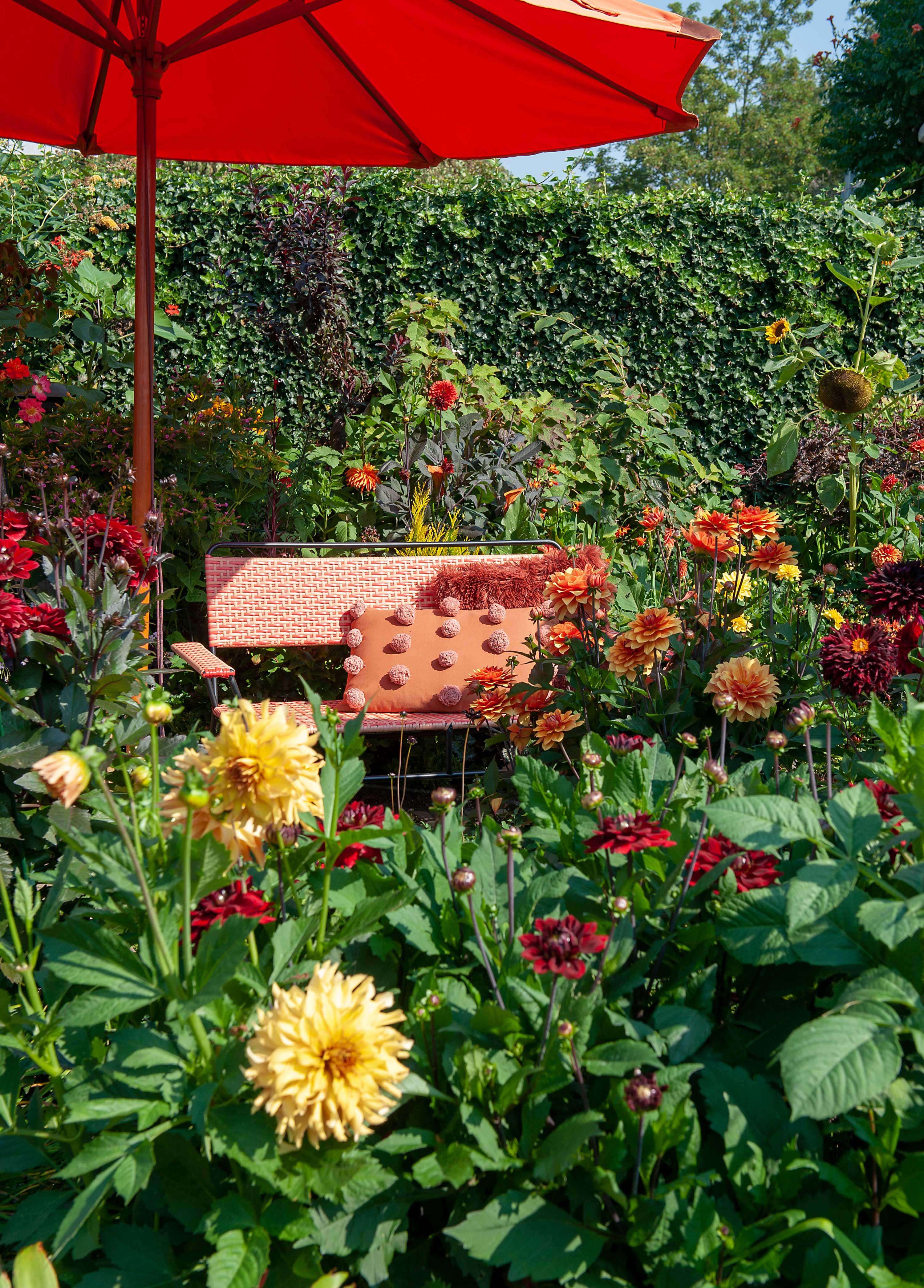
Hot reds, yellows and oranges will instantly pep up flower bed ideas with their warming tones. Dahlias 'Akita' and 'Sunny Reggae' are nothing short of spectacular.
You could add to the theme with sunflowers – 'Velvet Queen' is as luxurious as it sounds, offering deep-red petals and chocolate-brown centers. Rudbeckia 'Enchanted Embers' is also a fantastic choice, with semi-double blooms in fiery hues.
Why not continue the look with a flame-hued parasol, outdoor cushions, or seating option? Our colorful garden furniture ideas are full of vibrant choices.
17. Divide your plot with cottage-style flower beds
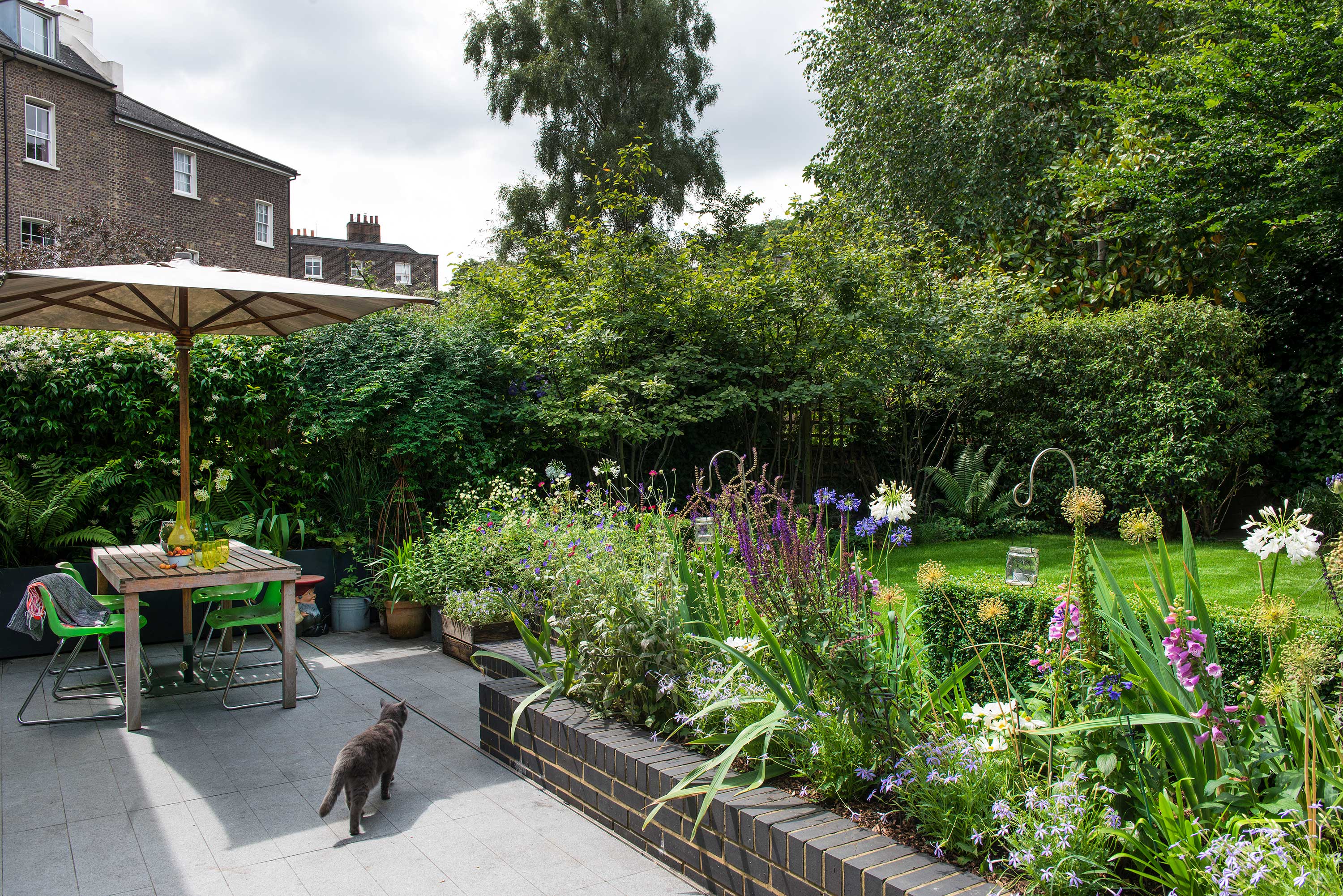
Cottage garden ideas will always be in style and it's simple to recreate the look in your flower beds.
Opt for quintessential classics such as digitalis, agapanthus, and salvias, and why not throw in some alliums too for good measure? They add a structural element even after the blooms have faded.
Use to soften the divide between levels as seen here, and edge with dark stone for a contemporary contrast. We also love the addition of a hanging lantern, which will help to illuminate the scene once night falls.
18. Add interest to a lawn with round flower beds
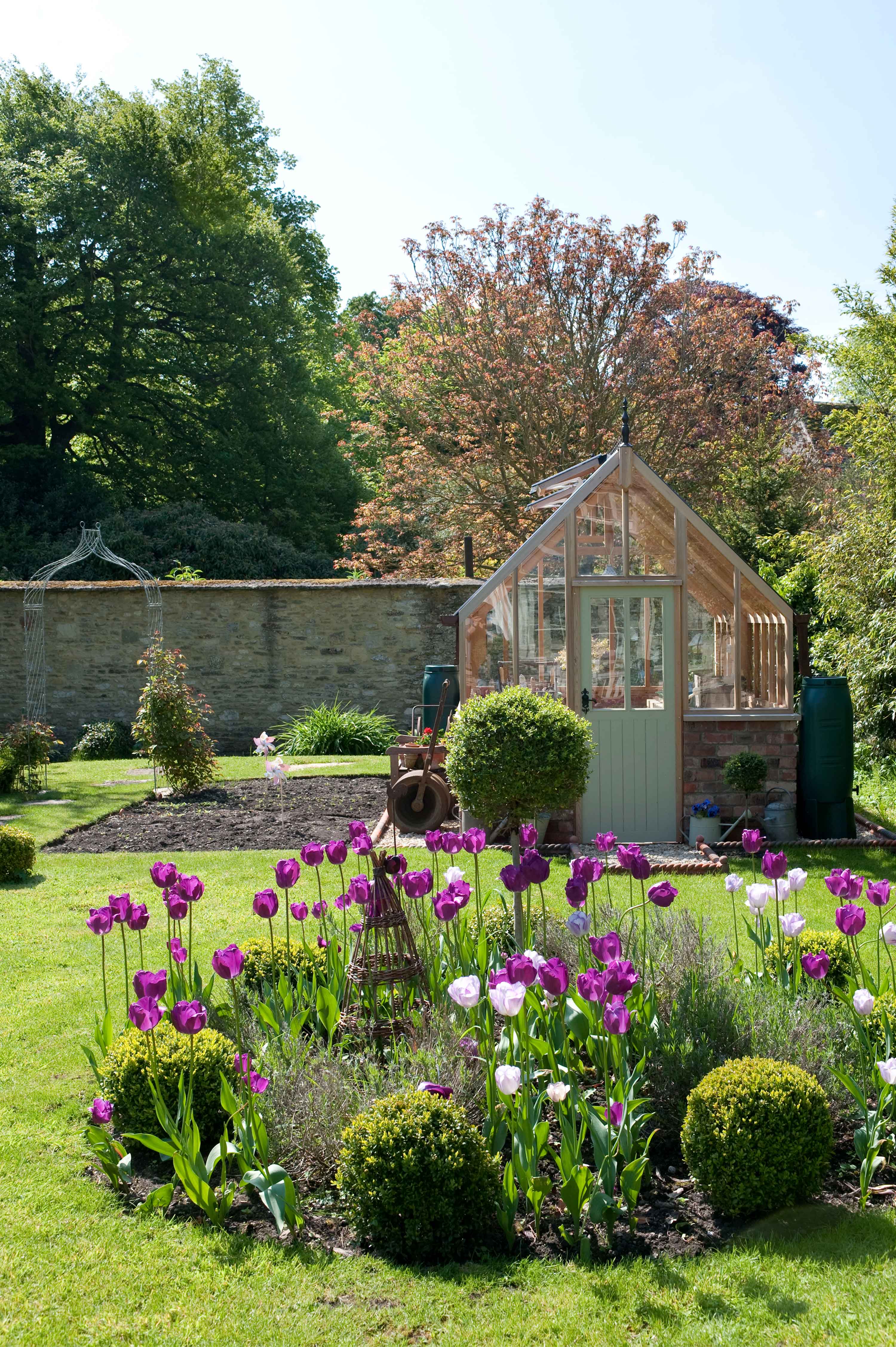
A round flower bed is a lovely way to liven up your lawn ideas.
Complement the shape with neatly-clipped topiary balls. Then, accent with brightly-colored blooms, such as these glorious tulips, for a fun look.
Low-maintenance shrubs such as lavender are a reliable addition, and why not add in an obelisk too? A woven one such as this adds a touch of country-style charm.
19. Use flowers to border a decking area
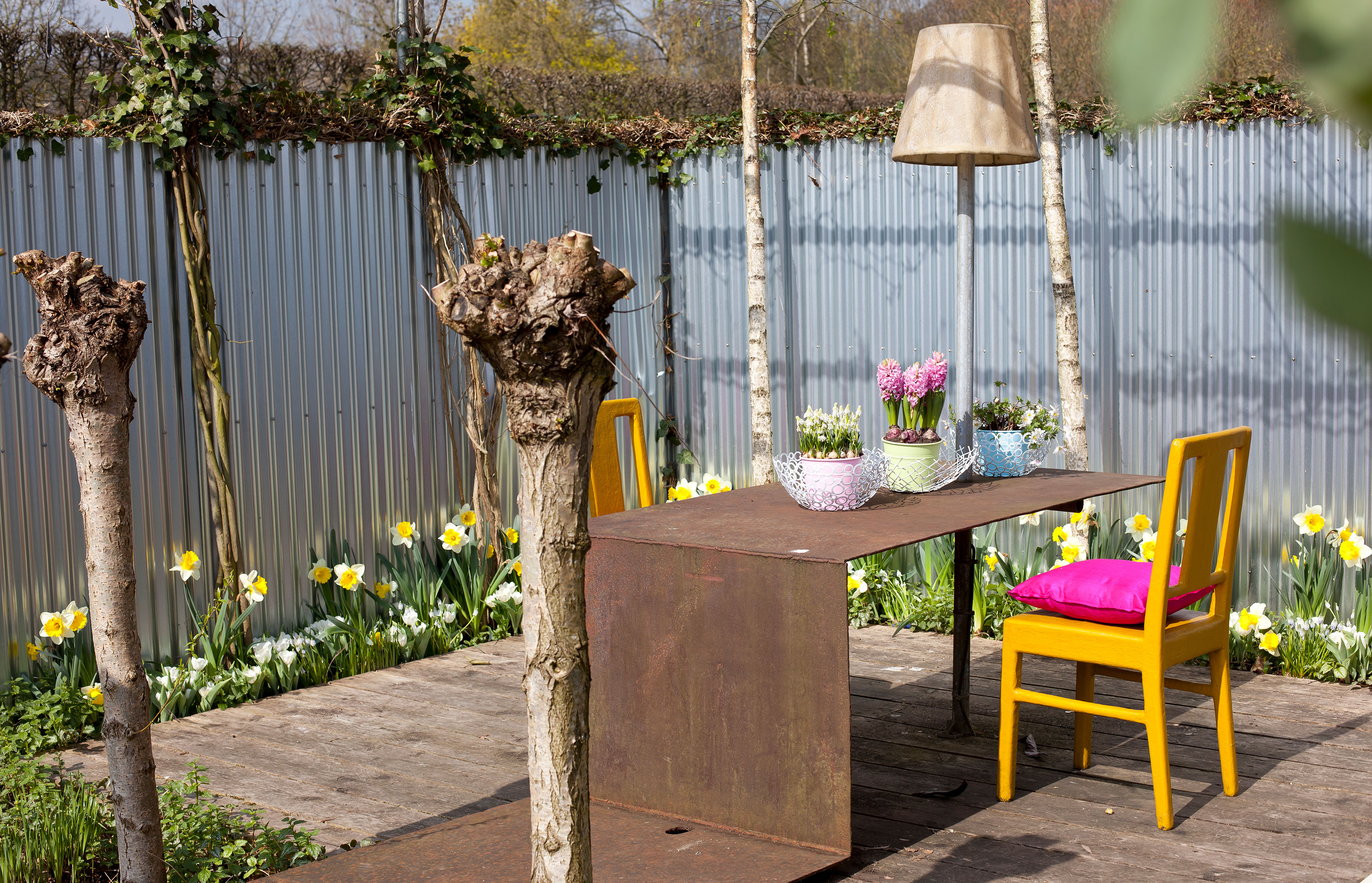
Corrugated fencing and an angular, rusted-steel table give this decking space an eccentrically industrial feel. You might even find it a little too urban, if it wasn't for the pops of color to brighten the look.
Of course, you can't miss the yellow chair and the pretty potted bulbs. But, the real feature point is a flower bed border, positioned all the way around the decking. Jolly daffodils and tulips will always add a hearty dose of spring cheer, but could be swapped out for summer annuals when the season turns – think cosmos, cornflowers, or poppies.
What's more, the stark contrast between the soft, colorful petals and corrugated metal backdrop behind adds a refreshing twist that feels totally modern.
20. Opt for curved flower bed ideas
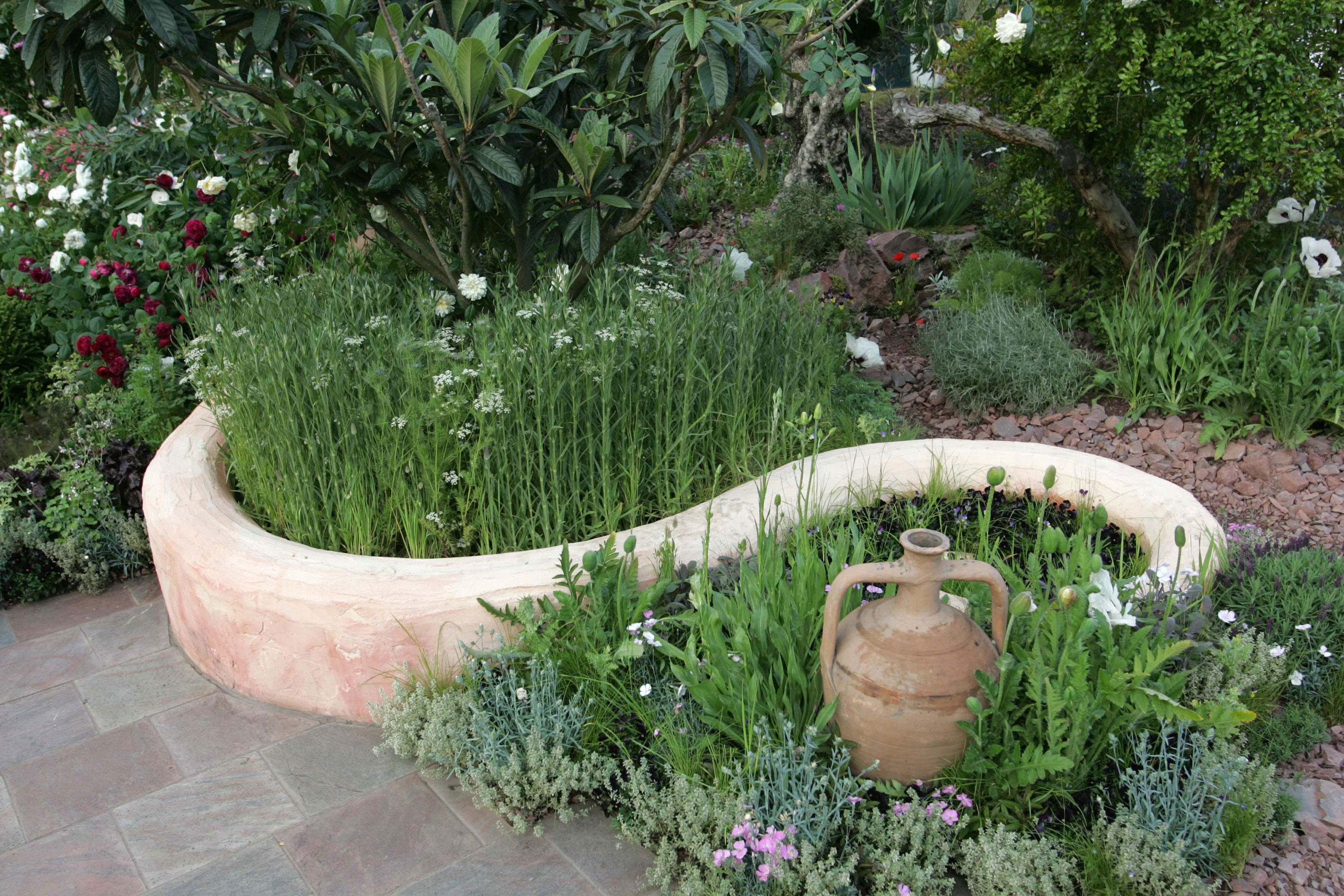
A pared-back, S-shaped wall such as this adds a soothing sense of movement to a space, whilst providing opportunity for creativity across levels.
Planted up with wildflowers, such as poppies and Ammi majus, the organic vibe is enhanced. Come summer, this display will burst into life, and will be a real show-stopper.
The addition of an old stone urn only adds to the charm and provides a focal point all year-round.
21. Use the vertical space in narrow plots
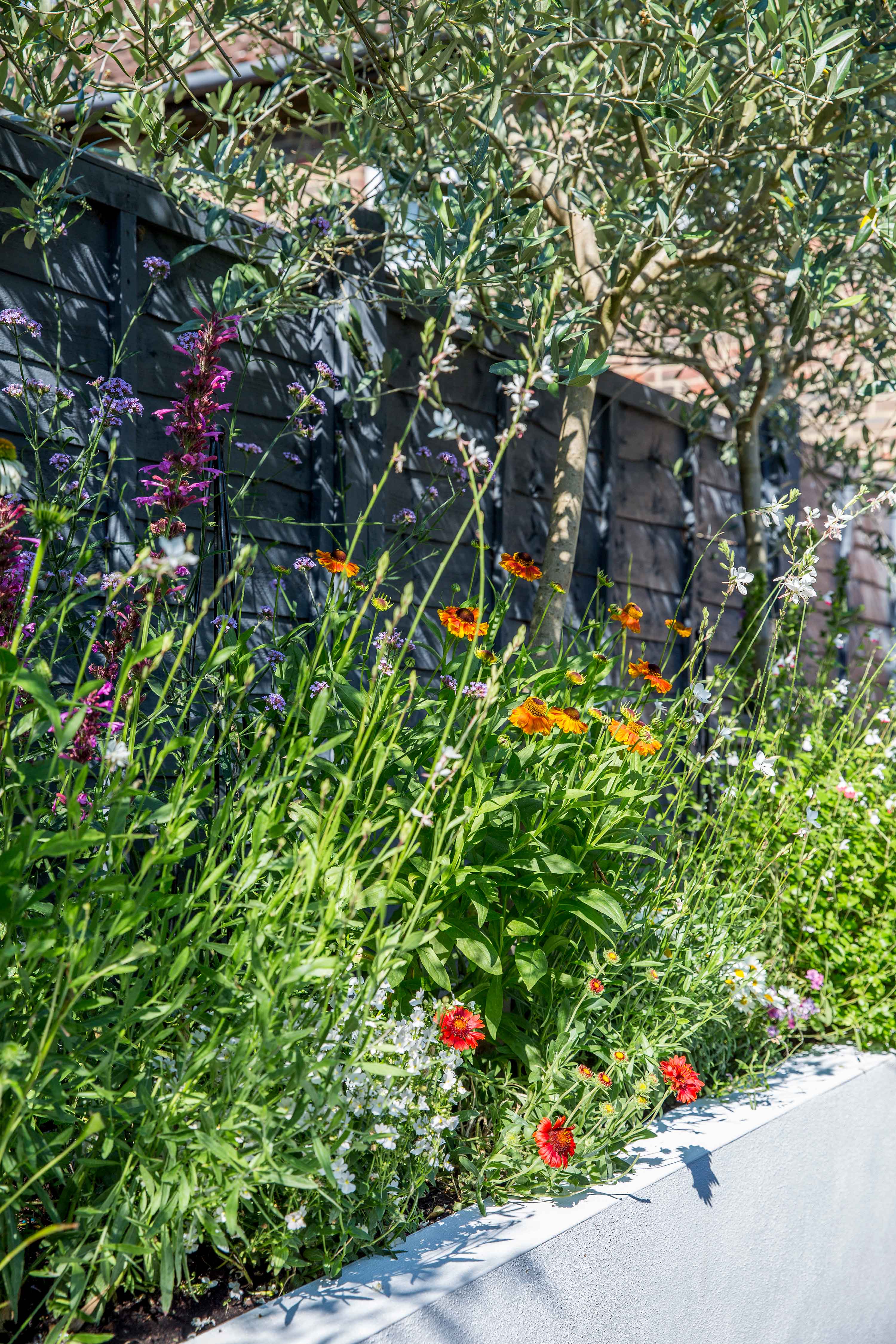
Short on space? You don't need to sacrifice having a fabulous flower bed or two. The solution is simply to think vertically. We don't mean living walls (although they are equally good for small gardens). Instead, we're talking about raising up your flower beds to line a perimeter.
These beds don't have to be generously wide. Even narrow beds can be filled with high-reaching flowers for an impressive, almost cocooning-like effect around a courtyard plot. Use the likes of Verbena bonariensis, white gaura, and heleniums for a joyous display of summer color. You could even add in a small olive tree or acer, for extra height and interest.
Paint the sides of the beds white to help reflect the light and add to the feeling of space. Paint the fence behind black to recede it out of focus.
22. Pair pastels with rosemary for a soothing style
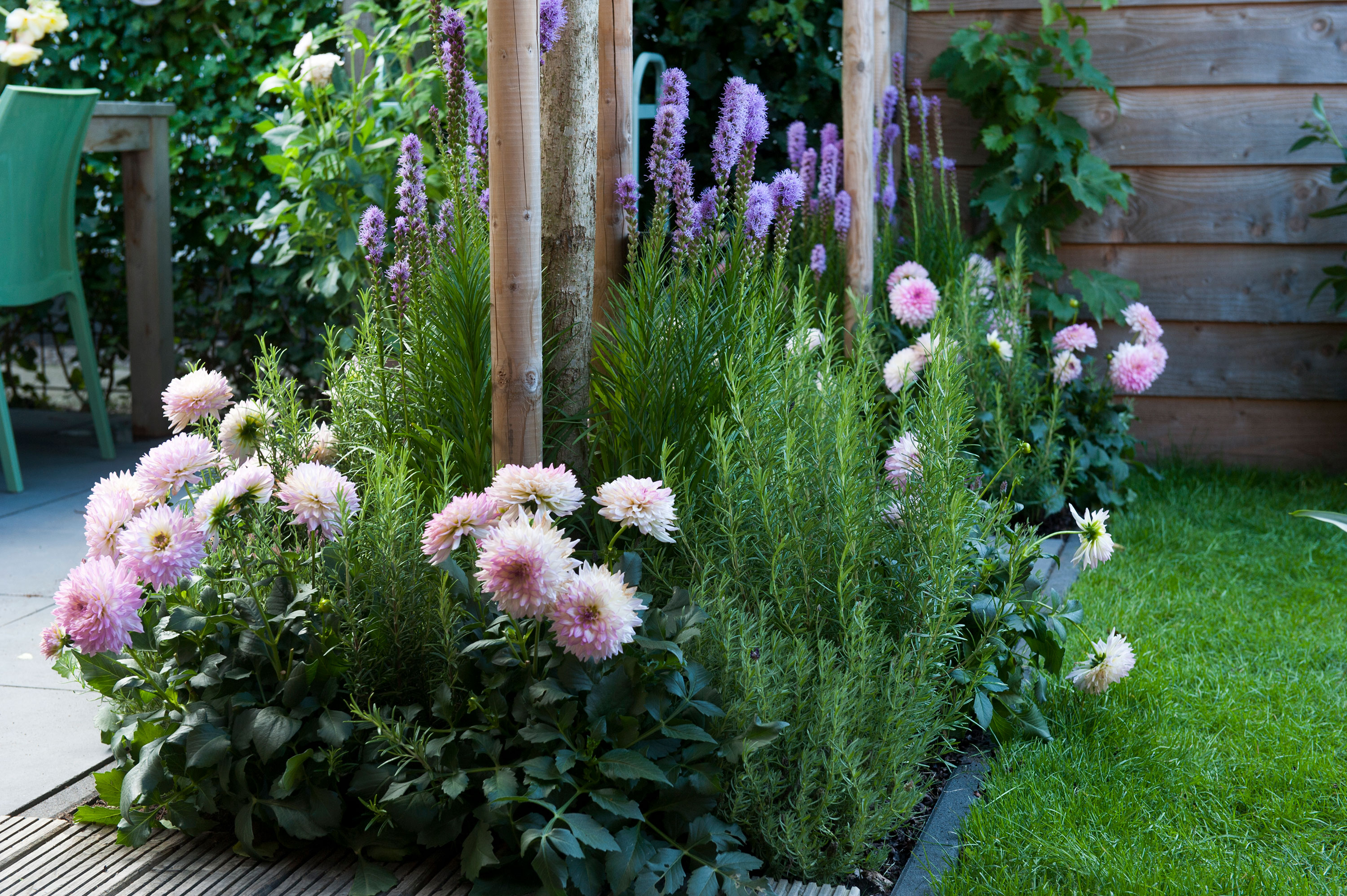
After a romantic touch to your garden? Why not divide a patio from a lawn with a pleasing pocket of billowing florals, as seen here.
Liatris spicata offers bottle-brush-like blooms and comes in white as well as purple, whilst pastel-hued dahlias are always a favorite with their intricate flowers.
Add deeply-fragranced foliage such as rosemary to entice the senses further. Its evergreen nature will hold your interest over winter and the dainty blue flowers that appear in spring are a true delight to behold.
23. Divide your space with structural flower beds
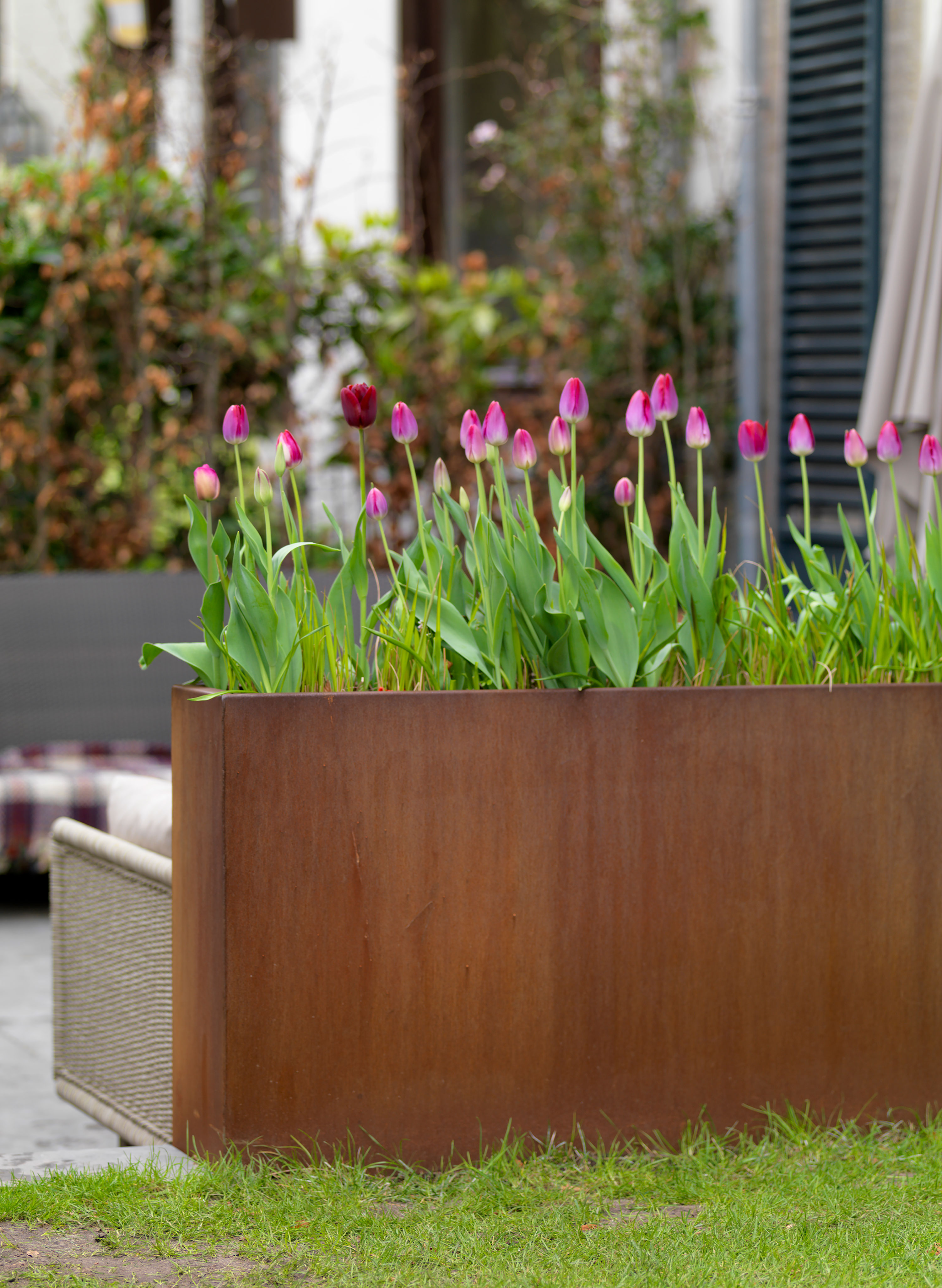
Weathering steel is a seriously on-trend material, and it's easy to see why. It adds a wonderfully rustic edge and a warming tone to a space, it is incredibly durable, and is pretty much maintenance-free.
So, if you love the look as much as we do, why not integrate it into your flower beds? It's great for container gardening ideas, as seen here, where tall planters house rows of glossy pink tulips. They define the seating area beyond in a stunning and structural way.
It's a great choice for modern or smaller plots – there's no hassle with digging up the ground to make beds for your blooms.
24. Brighten a shady spot
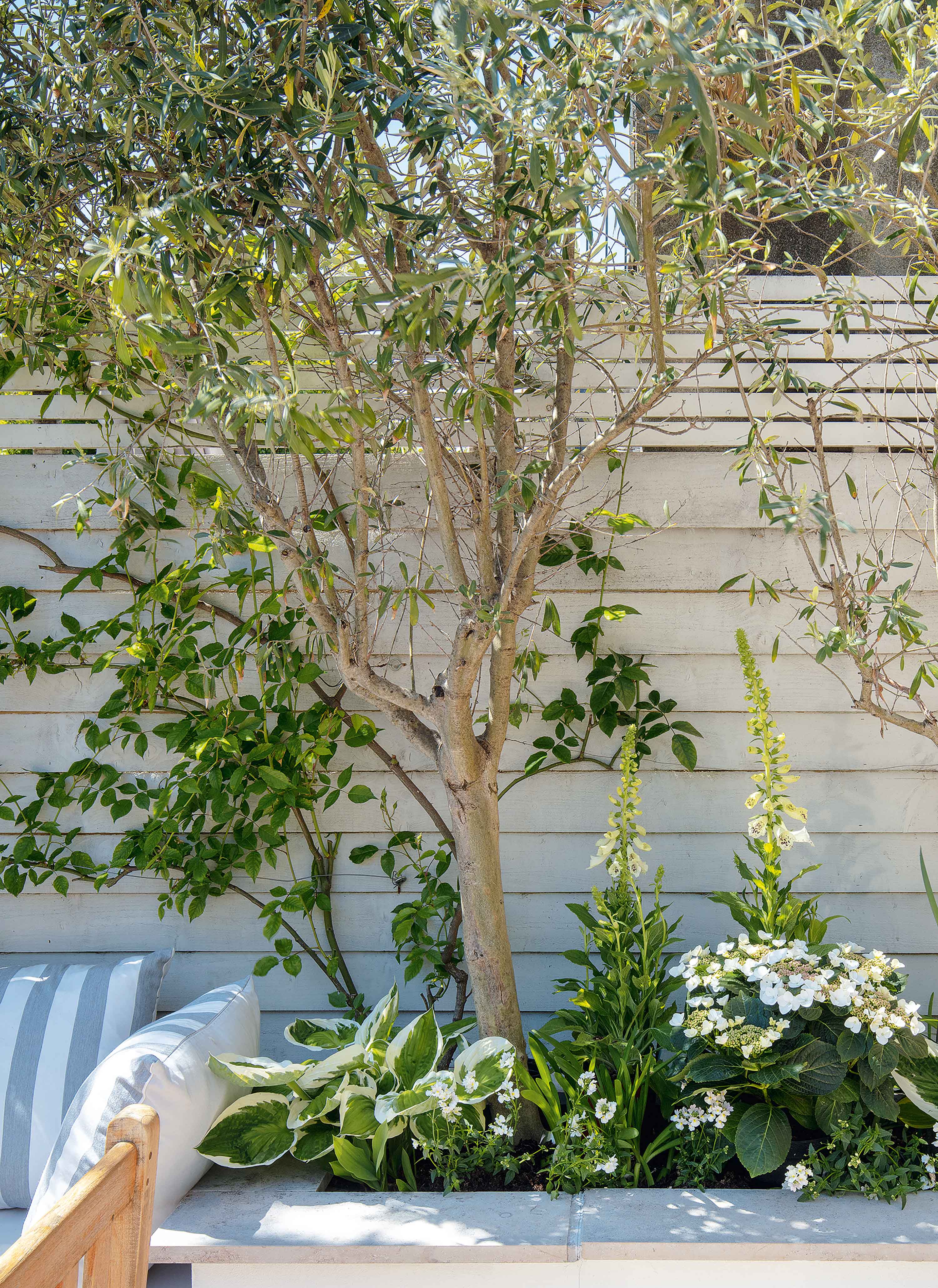
As seen here, hostas, hydrangeas, and digitalis make a gorgeously elegant mix, especially when chosen in a white-toned theme. A white fence behind lifts the spot further, as does the sleek stone edging.
It's a perfect shade garden idea for transforming a gloomier corner.
How do I make my flower beds look good?
It's relatively simple to make your flower bed ideas look good, you just need to take a few factors into consideration:
- Use a complementary color palette for a well-balanced look.
- Make sure your flower bed ideas have something for all seasons, to maintain visual interest all year.
- Keep on top of weeding and deadheading.
- Top-dress beds and borders with mulch – bark chippings add a pleasing look.
- Consider using modern edging to define the space and make maintenance easier. There are tons of lovely designs available.
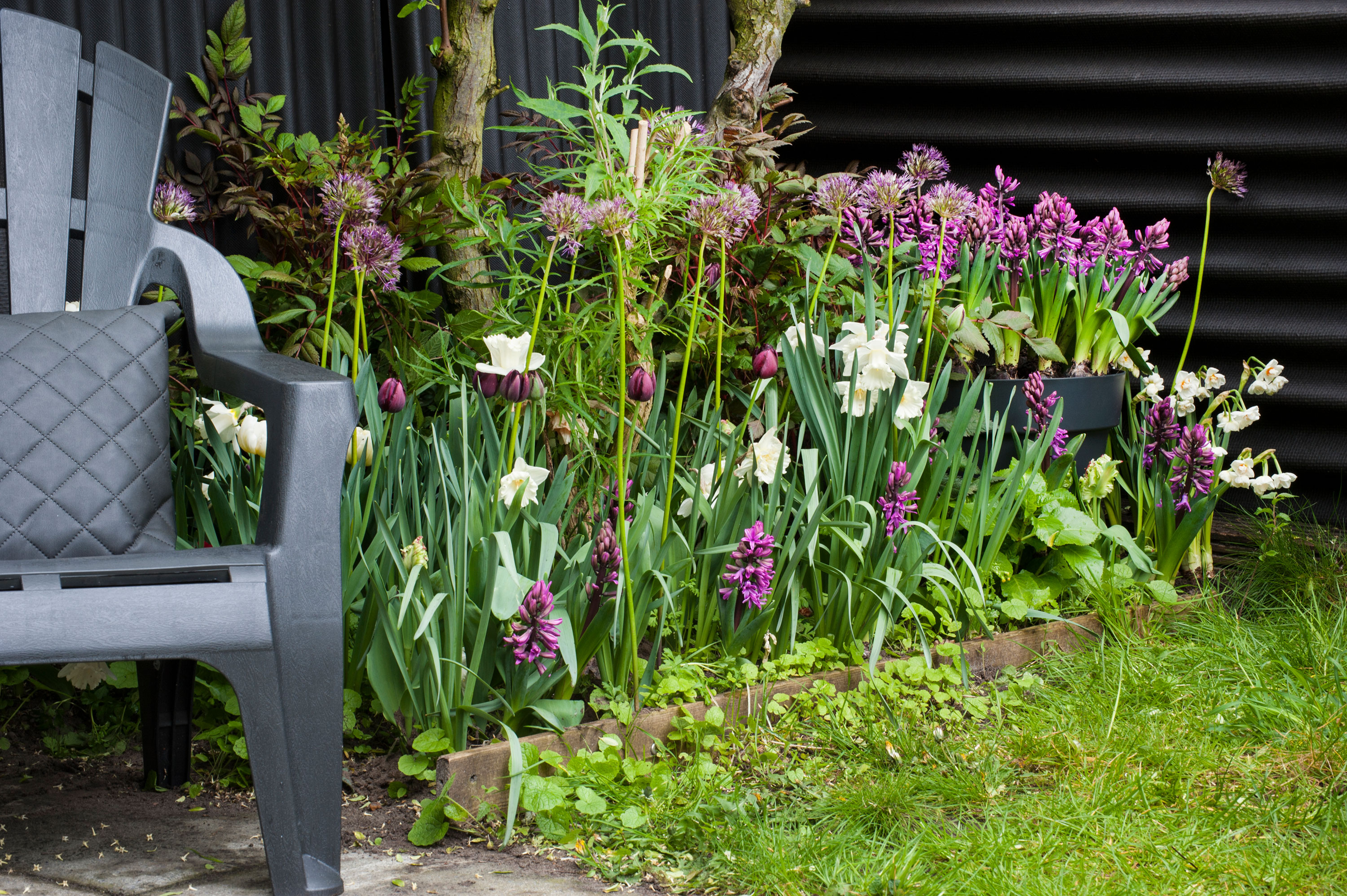
How do I make my flower beds less maintenance?
- Prep your soil before you plant your flower bed ideas. This means removing any perennial weeds to start. And, if it hasn't been planted up before, dig in one or two bucketfuls per square meter of well-rotted farmyard manure or garden compost, as suggests the RHS.
- Choose your plants carefully by taking the conditions of your garden into account. Don't, for instance, try to coerce a sun-loving plant into your shady border. You'll just end up having to give it extra attention – which will most likely be in vain – before needing to replace it entirely. Not very low maintenance at all!
- Go for easy-care perennials – ones you can more-or-less leave, before giving them a quick chop in autumn. You could also opt for hardy annuals – grown from seed they are extremely affordable and often don't need much looking after.
- Avoid opting for hundreds of different varieties. If you pick a select few, and really get to know them properly, you can deal with them all at the same time. Plus, you'll spend less time having to look up how to maintain them.
- Don't forget to mulch. It adds extra nutrients to the soil and will also help to prevent weeds from taking over. Our guide to mulching has lots of useful tips.
You can find more low maintenance garden ideas in our feature.
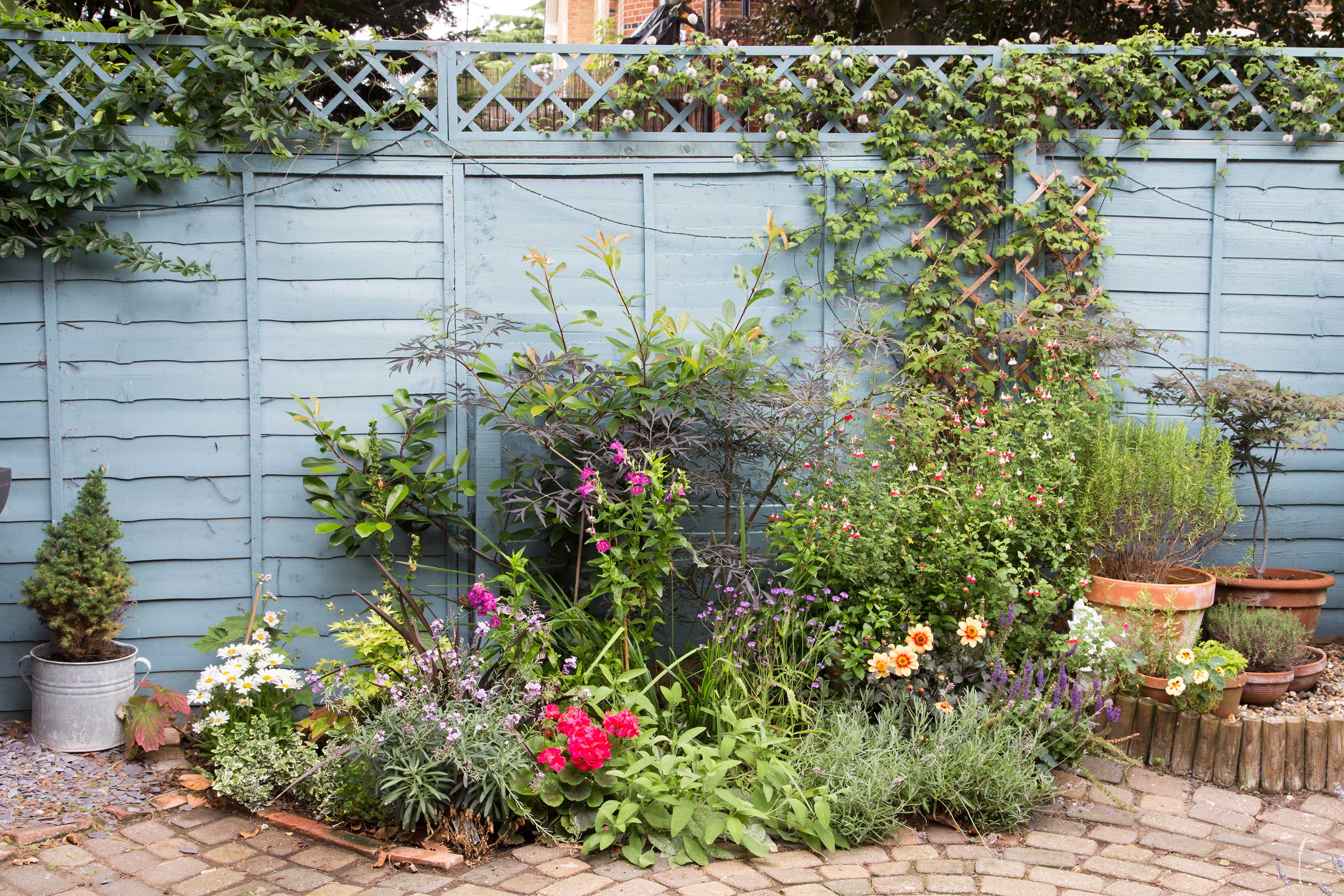
How do you lay out a flower bed?
When it comes to laying out your flower bed ideas, Chris Bonnett at GardeningExpress.co.uk has some expert advice:
- It's wise to keep your taller plants along the property line. A great tip is to keep these plants as tall as your bed is deep.
- Planting flowers of the same type in groups within the bed creates a better flow across your garden than just planting singularly. Make sure no plant is left lonely.
- Start your beds with evergreens and perennials – the stalwarts. Then draw people into your statement beds with vibrant color.
- Remember, you can never have too much color in your garden, but if your color scheme is all over the place it can be a real eyesore, adds Chris. Consider a complementary palette and stick with it.
You can find more garden border planting ideas in our dedicated guide.
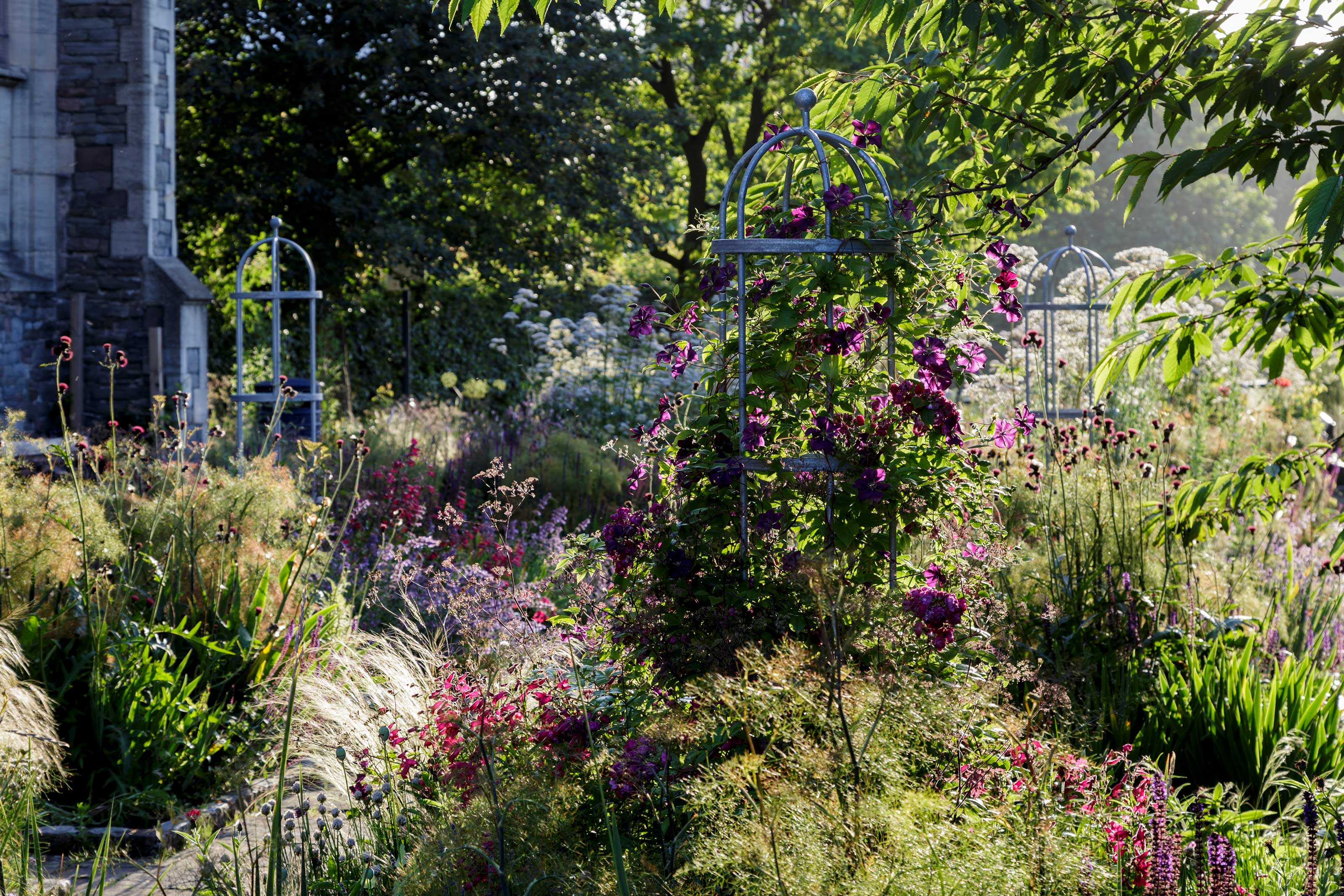
Should flower beds be higher than the lawn?
'Generally, if your flower beds meet the grass, it's best to keep your beds lower than your lawn,' says Chris Bonnett at GardeningExpress.co.uk.
'This will make mowing the grass less of a nightmare and will stop your beds from interfering with your lawn's growth,' he adds.
Don't forget about garden edging ideas too, which will help to keep the two areas neatly distinct.


The garden was always a big part of Holly's life growing up, as was the surrounding New Forest where she lived. Her appreciation for the great outdoors has only grown since then. She's been an allotment keeper, a professional gardener, and a botanical illustrator – plants are her passion.
